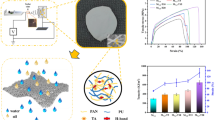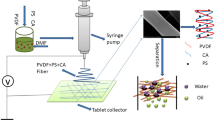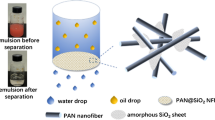Abstract
Through sequential electrospinning, a sandwich Janus membrane (PU-(CA/PU)-CA) was constructed with hydrophobic polyurethane (PU) nanofiber membrane as the top layer, cellulose acetate/polyurethane (CA/PU) blend nanofiber membrane as the intermediate transition layer and hydrophilic cellulose acetate (CA) nanofiber membrane as the bottom layer. The effects of membrane structure, composition and thickness on the mechanical properties, permeability and separation ability of PU-(CA/PU)-CA nanofiber membrane were studied. The results show that the transition sandwich structure PU-(CA/PU)-CA membrane has good mechanical properties, high permeability and selective separation ability, and can realize the unidirectional transmission of water and efficient oil–water separation. When the membrane thickness is 80 μm, the hydraulic permeability is 3.4 ± 0.4 × 104 L/(m2 h bar), the oil–water separation efficiency reaches 99 ± 0.4%, and the tensile strength is 95.8% higher than that of the double-layer PU-CA membrane. The thermal stability and antifouling ability of PU-(CA/PU)-CA nanofiber membrane have also been improved, and the reusability is good. CA/PU transition interlayer improves the interfacial compatibility between CA and PU nanofiber membrane, enhances the performance of PU-(CA/PU)-CA nanofiber Janus membrane, and shows its application prospect in the field of separation and purification.
Graphical abstract







Similar content being viewed by others
References
Arkhangelsky E, Duek A, Gitis V (2012) Maximal pore size in UF membranes. J Membr Sci 394–395:89–97
Arthanareeswaran G, Thanikaivelan P, Srinivasn K, Mohan D, Rajendran M (2004) Synthesis, characterization and thermal studies on cellulose acetate membranes with additive. Eur Polymer J 40:2153–2159
Bates C, Ileana I, Loranger É, Mathew AP, Chabot B (2021) Cellulose reinforced electrospun chitosan nanofibers bio-based composite sorbent for water treatment applications. Cellul 28:4865–4885
Chen Y, Kim S, Cohen Y (2021) Tuning the hydraulic permeability and molecular weight cutoff (MWCO) of surface nano-structured ultrafiltration membranes. J Membr Sci 629:119180
Coutinho FMB, Delpech MC, Alves TL, Ferreira AA (2003) Degradation profiles of cast films of polyurethane and poly(urethane-urea) aqueous dispersions based on hydroxy-terminated polybutadiene and different diisocyanates. Polym Degrad Stab 81:19–27
Cui J, Li F, Wang Y, Zhang Q, Ma W, Huang C (2020) Electrospun nanofiber membranes for wastewater treatment applications. Sep Purif Technol 250:117116
Dai R, Li J, Wang Z (2020) Constructing interlayer to tailor structure and performance of thin-film composite polyamide membranes: a review. Adv Colloid Interface Sci 282:102204
Guzman D, Reyes M, Chester KA, Andra MB, Ang MY, Gian VC, Dizon AR, Caparanga S-HH, Lee K-R (2021) Increased performance and antifouling of mixed-matrix membranes of cellulose acetate with hydrophilic nanoparticles of polydopamine-sulfobetaine methacrylate for oil-water separation. J Membr Sci 620:118881
Fong H, Chun I, Reneker DH (1999) Beaded nanofibers formed during electrospinning. Polymer 40:4585–4592
Hu L, Gao S, Zhu Y, Zhang F, Jiang L, Jin J (2015) An ultrathin bilayer membrane with asymmetric wettability for pressure responsive oil/water emulsion separation. J Mater Chem A 3:23477–23482
Iqhrammullah, M., Marlina Marlina, H. P. S. Abdul Khalil, K. H. Kurniawan, H. Suyanto, R. Hedwig, I. Karnadi, N. G. Olaiya, C. K. Abdullah, and S. N. Abdulmadjid. 2020. 'Characterization and Performance Evaluation of Cellulose Acetate-Polyurethane Film for Lead II Ion Removal.', Polymers, 12.
Jiang L, Li Ke, Yang H, Liu X, Li W, Weilin Xu, Deng Bo (2020) Improving mechanical properties of electrospun cellulose acetate nanofiber membranes by cellulose nanocrystals with and without polyvinylpyrrolidone. Cellul 27:955–967
Ju X, Jin-Peng L, Zhao L-L, Tian-Dan L, Cao X-L, Jia T-Z, Wang Y-C, Sun S-P (2021) Electrospun transition layer that enhances the structure and performance of thin-film nanofibrous composite membranes. J Membr Sci 620:118927
Li H, Wang X, He Y, Peng L (2019) Facile preparation of fluorine-free superhydrophobic/superoleophilic paper via layer-by-layer deposition for self-cleaning and oil/water separation. Cellul 26:2055–2074
Liu H, Huang J, Li F, Chen Z, Zhang K-Q, Al-Deyab SS, Lai Y (2017) Multifunctional superamphiphobic fabrics with asymmetric wettability for one-way fluid transport and templated patterning. Cellul 24:1129–1141
Liu Y, Qu R, Zhang W, Li X, Wei Y, Feng L (2019) Lotus- and Mussel-Inspired PDA–PET/PTFE Janus Membrane: Toward Integrated Separation of Light and Heavy Oils from Water. ACS Appl Mater Interfaces 11:20545–20556
Liu Y, Zhan B, Zhang K, Kaya C, Stegmaier T, Han Z, Ren L (2018) On-demand oil/water separation of 3D Fe foam by controllable wettability. Chem Eng J 331:278–289
Lucena M, da Conceição C, Ana EV, de Alencar S, Mazzeto E, de Soares S A. (2003) The effect of additives on the thermal degradation of cellulose acetate. Polym Degrad Stab 80:149–155
Lv J, Zhang G, Zhang H, Yang F (2017) Exploration of permeability and antifouling performance on modified cellulose acetate ultrafiltration membrane with cellulose nanocrystals. Carbohyd Polym 174:190–199
Nosar MN, Salehi M, Ghorbani S, Beiranvand SP, Goodarzi A, Azami M (2016) Characterization of wet-electrospun cellulose acetate based 3-dimensional scaffolds for skin tissue engineering applications: influence of cellulose acetate concentration. Cellul 23:3239–3248
Pan J, Xiao C, Huang Q, Liu H, Zhang T (2017) ECTFE hybrid porous membrane with hierarchical micro/nano-structural surface for efficient oil/water separation. J Membr Sci 524:623–630
Petrović ZS, Zavargo Z, Flyn JH, Macknight WJ (1994) Thermal degradation of segmented polyurethanes. J Appl Polym Sci 51:1087–1095
Qing W, Shi X, Deng Y, Zhang W, Wang J, Tang CY (2017) Robust superhydrophobic-superoleophilic polytetrafluoroethylene nanofibrous membrane for oil/water separation. J Membr Sci 540:354–361
Riaz T, Ahmad A, Saleemi S, Adrees M, Jamshed F, Hai AM, Jamil T (2016) Synthesis and characterization of polyurethane-cellulose acetate blend membrane for chromium (VI) removal. Carbohyd Polym 153:582–591
Song H-M, Chen C, Shui X-X, Yang H, Zhu L-J, Zeng Z-X, Xue Q-J (2019) Asymmetric Janus membranes based on in situ mussel-inspired chemistry for efficient oil/water separation. J Membr Sci 573:126–134
Su R, Li S, Wanlin W, Song C, Liu G, Yang Y (2021) Recent progress in electrospun nanofibrous membranes for oil/water separation. Sep Purif Technol 256:117790
Tan L, Jinlian Hu, Huang H, Han J, Huawen Hu (2015) Study of multi-functional electrospun composite nanofibrous mats for smart wound healing. Int J Biol Macromol 79:469–476
Tang C, Chen P, Liu H (2008) Cocontinuous cellulose acetate/polyurethane composite nanofiber fabricated through electrospinning. Polym Eng Sci 48:1296–1303
Wang X, Jianyong Yu, Sun G, Ding B (2016a) Electrospun nanofibrous materials: a versatile medium for effective oil/water separation. Mater Today 19:403–414
Wang Z, Wang Yu, Liu G (2016b) Rapid and efficient separation of oil from oil-in-water emulsions using a janus cotton fabric. Angew Chem Int Ed 55:1291–1294
Wu J, Wang Nü, Wang Li, Dong H, Zhao Y, Jiang L (2012) Unidirectional water-penetration composite fibrous film via electrospinning. Soft Matter 8:5996–5999
Xie A, Cui J, Liu Y, Xue C, Wang Y, Dai J (2021) Preparation of Janus membrane based on biomimetic polydopamine interface regulation and superhydrophobic attapulgite spraying for on-demand oil-water emulsion separation. J Membr Sci 627:119242
Yang H-C, Hou J, Chen V, Zhi-Kang Xu (2016) Janus membranes: exploring duality for advanced separation. Angew Chem Int Ed 55:13398–13407
Yao A, Yan Y, Tan L, Shi Y, Zhou M, Zhang Y, Zhu P, Huang S (2021) Improvement of filtration and antifouling performance of cellulose acetate membrane reinforced by dopamine modified cellulose nanocrystals. J Membr Sci 637:119621
Yao C, Xinsong Li KG, Neoh ZS, Kang ET (2008) Surface modification and antibacterial activity of electrospun polyurethane fibrous membranes with quaternary ammonium moieties. J Membr Sci 320:259–267
Yin X, Wen Y, Li Y, Liu P, Li Z, Shi Y, Lan J, Guo R, and Tan L. 2018. 'Facile Fabrication of Sandwich Structural Membrane With a Hydrogel Nanofibrous Mat as Inner Layer for Wound Dressing Application', Frontiers in Chemistry, 6.
Zavastin D, Cretescu I, Bezdadea M, Bourceanu M, Drăgan M, Lisa G, Mangalagiu I, Vasić V, Savić J (2010) Preparation, characterization and applicability of cellulose acetate–polyurethane blend membrane in separation techniques. Colloids Surf, A 370:120–128
Zhang J, Ge J, Si Y, Zhang F, Jianyong Yu, Liu L, Ding B (2019a) Taro leaf-inspired and superwettable nanonet-covered nanofibrous membranes for high-efficiency oil purification. Nanoscale Horizons 4:1174–1184
Zhang J, Zhang F, Song J, Liu L, Si Y, Jianyong Yu, Ding B (2019b) Electrospun flexible nanofibrous membranes for oil/water separation. J Mater Chem A 7:20075–20102
Zhang J, Yang Y, Zhang Z, Wang P, Wang X (2014) Biomimetic multifunctional nanochannels based on the asymmetric wettability of heterogeneous nanowire membranes. Adv Mater 26:1071–1075
Zhang YQ, Yang XB, Wang ZX, Long J, Shao Lu (2017) Designing multifunctional 3D magnetic foam for effective insoluble oil separation and rapid selective dye removal for use in wastewater remediation. J Mater Chem A 5:7316–7325
Zhang Y, Tan L, Yao A, Tan P, Guo R, Zhou Mi, Zhu P, Huang S, Yunheng Wu (2021) Improvement of filtration performance of polyvinyl chloride/cellulose acetate blend membrane via acid hydrolysis. J Appl Polym Sci 138:50312
Acknowledgments
This work was sponsored by the National Natural Science Foundation of China (Nos. 22075189, 51803128, 52073186), Strategic Cooperation between Sichuan University and Yibin City (No. 2019CDYB-30), Strategic Project of Zi Gong Science & Technology Bureau (Nos. 2019CDZG-S15, 2020CDZG-15), and Funding of Engineering Characteristic Team, Sichuan University (2020SCUNG122).
Funding
This work was sponsored by the National Natural Science Foundation of China (Nos. 22075189, 51803128, 52073186), Strategic Cooperation between Sichuan University and Yibin City (No. 2019CDYB-30), Strategic Project of Zi Gong Science & Technology Bureau (Nos. 2019CDZG-S15, 2020CDZG-15), and Funding of Engineering Characteristic Team, Sichuan University (2020SCUNG122).
Author information
Authors and Affiliations
Contributions
Yong Zhang: Conceptualization, Data Curation, Writing—Original Draft, Funding acquisition. Mei Yang: Formal analysis. Yuan Zhou: Investigation, Data Curation. Anrong Yao: Investigation, Data Curation, Writing—Original Draft. Yanting Han: Data Curation. Yidong Shi: Project administration. Fei Cheng: Resources. Mi Zhou: Resources. Puxin Zhu: Supervision. Lin Tan: Conceptualization, Methodology, Project administration, Funding acquisition.
Corresponding author
Ethics declarations
Conflicts of interest
All authors declare that they have no conflict of interest.
Consent for publication
Yes, my co-authors and I would like to publish.
Additional information
Publisher's Note
Springer Nature remains neutral with regard to jurisdictional claims in published maps and institutional affiliations.
Supplementary Information
Below is the link to the electronic supplementary material.
Supplementary file1 (MP4 14204 kb)
Rights and permissions
About this article
Cite this article
Zhang, Y., Yang, M., Zhou, Y. et al. Transition sandwich Janus membrane of cellulose acetate and polyurethane nanofibers for oil–water separation. Cellulose 29, 1841–1853 (2022). https://doi.org/10.1007/s10570-021-04402-8
Received:
Accepted:
Published:
Issue Date:
DOI: https://doi.org/10.1007/s10570-021-04402-8




